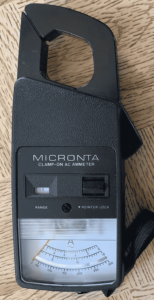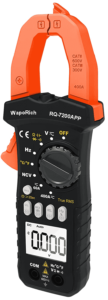
I imagine many readers of this blog have some idea how a clamp-on AC ammeter works. You have some wire with AC current in it, and you open the jaws of a clamp-on meter and you close them around the wire. The alternating current makes a constantly changing magnetic field around the wire. It is a fairly realistic goal for the jaws to capture basically all of the lines of (constantly changing) magnetic flux surrounding the wire. If you have the luxury of being able to assume that the frequency is known (and depending on the continent where you are located, this may well be a safe assumption), you can proceed in a very straightforward way to design a simple and inexpensive and quite accurate AC ammeter. I have had this Micronta (Radio Shack) meter (seen at right) in my tool kit for some fifty years now, and it has served me very well.
But nowadays there are clamp-on DC ammeters. A wire carrying a DC current does not (by definition it does not!) generate any changing magnetic field! A traditional meter like the one described above has nothing to measure if it is clamped onto a wire containing a DC current. How can a clamp-on DC ammeter possibly measure a (perhaps constant) DC current?

Here at right you can see such a meter. It looks quite a lot like an old-fashioned clamp-on AC ammeter, differing mostly in that it has a digital display instead of the d’Arsonval (meter movement) display. How the heck does it measure a static DC current in a wire?
The answer, it turns out, is that the jaws define a mostly closed-loop flux path that is broken by a Hall-effect sensor (Wikipedia article). The Hall-effect sensor is able to sense the absolute amount of static B field that is present. With appropriate electronics and appropriate calibration, the clamp-on meter can sense AC current or DC current.
This particular unit also provides a non-contact AC sensor at the tip of the jaws. It also provides old-fashioned digital multimeter functions via test probes, measuring such things as voltage, resistance, frequency, capacitance, continuity, and diode voltage drop. It offers a bright flashlight. The digital display is backlit. The meter is (of course) auto-ranging and auto-polarity. The continuity function can optionally provide not only a beep but also flashing of the flashlight.
This unit can also link via Bluetooth to an app on your smart phone which can log your measurements for later downloading to a computer.
My chief reason for getting one of these clamp-on DC ammeters is to check the accuracy of current readings on the display of an inexpensive inverter-type welder. Yes, folks, I recently took a stick welding class (course listing) at a local industrial gas and welding supply store. The instructor was really excellent!
I have in mind blogging a bit about the process of trying to learn how to do stick welding.
Have you done stick welding? If so, what is your favorite welding rod? 6010? 6011? 6013? 7014? 7018? Please post a comment below.

Did you get one of those auto darkening welding lenses?
Yes it turns out that a nice auto darkening helmet does not cost nearly as much as they used to cost. Here is what I purchased at a mere $40: https://www.amazon.com/gp/product/B07QJ1Y527/ .
thumbs up!
A while ago I bought this to monitor my outdoor bucket heaters:
https://www.amazon.com/Poniie-PN2000-Electricity-Electrical-Consumption/dp/B0777H8MS8